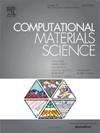On the effect of elastic anisotropy and polarizability on solute segregation at low-angle grain boundaries
IF 3.3
3区 材料科学
Q2 MATERIALS SCIENCE, MULTIDISCIPLINARY
引用次数: 0
Abstract
Solute segregation towards grain boundaries is investigated by modeling solute atoms as elastic dipoles interacting with the strain fields of symmetric tilt low-angle grain boundaries (LAGBs). Elastic dipoles are determined using molecular statics (MS) considering both the permanent second-rank tensor and the fourth-rank polarizability tensor, which is needed to capture the elastic dipole dependence on external strain. For cubic lattices, the latter tensors are related to size and modulus effects, respectively. The strain fields of LAGBs are evaluated either through MS or by considering arrays of edge dislocations within the framework of linear isotropic elasticity or heterogeneous anisotropic elasticity using the Stroh formalism. The interaction energies arising from the coupling between elastic dipoles and LAGB strain fields are compared to segregation energies computed on a site-by-site basis using MS. These comparisons are made for three LAGBs and two cubic systems (Cu and Ag) with solute atoms in substitution (Ag and Ni, respectively). The results underscore the critical role of anisotropic elasticity in accurately modeling solute segregation. Notably, variations in behavior between grain boundaries having a same tilt angle are only captured when anisotropic elasticity is considered. Furthermore, despite the inherent limitations in addressing non-linear effects at defect cores, the elastic dipole approximation proves to be an effective method for approximating segregation energy spectra in LAGBs obtained through atomistic simulations. Lastly, the estimation of overall solute concentration at grain boundaries highlights the prominent influence of the modulus effect.

弹性各向异性和极化率对低角晶界处溶质偏析的影响
通过模拟溶质原子与对称倾斜低角晶界(LAGBs)应变场相互作用的弹性偶极子,研究了溶质向晶界的偏析。利用分子静力学(MS)确定弹性偶极子,同时考虑永久二阶张量和四阶极化张量,以捕获弹性偶极子对外部应变的依赖关系。对于立方晶格,后一种张量分别与尺寸和模量效应有关。通过质谱法或考虑线各向同性弹性或非均质各向异性弹性框架内的边缘位错阵列,利用Stroh形式对lagb的应变场进行了评估。将弹性偶极子和LAGB应变场之间耦合产生的相互作用能与用ms逐点计算的偏析能进行了比较。这些比较是针对三个LAGB和两个溶质原子(分别为Ag和Ni)取代的立方体系(Cu和Ag)进行的。结果强调了各向异性弹性在精确模拟溶质偏析中的关键作用。值得注意的是,只有在考虑各向异性弹性时,具有相同倾角的晶界之间的行为变化才会被捕获。此外,尽管在处理缺陷核的非线性效应方面存在固有的局限性,但弹性偶极子近似被证明是一种有效的方法来近似通过原子模拟获得的lagb中的偏析能谱。最后,对晶界总溶质浓度的估计突出了模量效应的显著影响。
本文章由计算机程序翻译,如有差异,请以英文原文为准。
求助全文
约1分钟内获得全文
求助全文
来源期刊

Computational Materials Science
工程技术-材料科学:综合
CiteScore
6.50
自引率
6.10%
发文量
665
审稿时长
26 days
期刊介绍:
The goal of Computational Materials Science is to report on results that provide new or unique insights into, or significantly expand our understanding of, the properties of materials or phenomena associated with their design, synthesis, processing, characterization, and utilization. To be relevant to the journal, the results should be applied or applicable to specific material systems that are discussed within the submission.
 求助内容:
求助内容: 应助结果提醒方式:
应助结果提醒方式:


